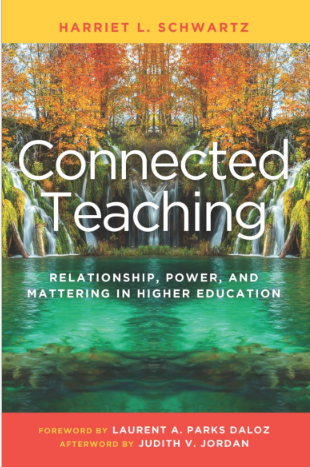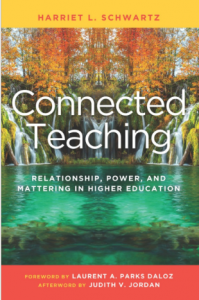This post was written for “What we’re reading“, a feature in the UBC Centre for Teaching, Learning and Technology’s Dialogues newsletter.
It is a short review of “Connected Teaching” by Harriet Schwartz, PhD.
****
In post-secondary teaching and learning, relationships matter.
They matter as much as (and possibly more than) course design, proper use of technology and other elements we typically associate with promoting understanding and “good teaching.”
Given my interest in the role of emotions in teaching and learning, I was eager to read Connected Teaching by Harriet Schwartz, PhD.
This book addresses the significance of the connection between students and faculty members and explores “teaching as a relational practice.” Drawing from Relational Cultural Theory (a theory Schwartz helps her reader learn about throughout the book), the author argues that “we are at our best when we have the capacity to engage and maintain growth-fostering relationships”. These relationships need not be long-term and can occur even in a single meaningful interaction.
Connected teaching, Schwartz describes, consists of five elements: energy, knowledge, sense of worth, action and desire for more connection. She proposes that care, presence, invitation and enthusiasm are essential elements of connected teaching because they convey to students that they matter and that their challenges are real.
What I especially appreciated about this book is that Schwartz does not depict connection as an easy process or a given. She writes honestly about disconnection, power, shame, blind spots and boundaries. That is, she is upfront about the challenges involved as we aim to build connection(s) with our learners.
What remains most with me about this book is Schwartz’s compelling messages about mattering and how it is central to connected teaching. Her work echoes other scholars’ work (see, for example, The Undergraduate Experience: Focusing Institutions on What Matters Most by Felten et al.), who have highlighted the importance of creating a sense of belonging to student learning. To “matter,” reminds Schwartz, is to feel we have a place in others’ lives, and our presence makes a difference to them.
If you are keen to explore the role of connection in teaching and learning, I recommend Connected Teaching.
Interested in learning more about Connected Learning before reading the book? Listen to this Teaching in Higher Ed podcast episode where Harriet Schwartz discusses her book.
Schwartz, H. L. (2019). Connected Teaching: Relationship, Power, and Mattering in Higher Education. Stylus Publishing, LLC.


 Follow
Follow